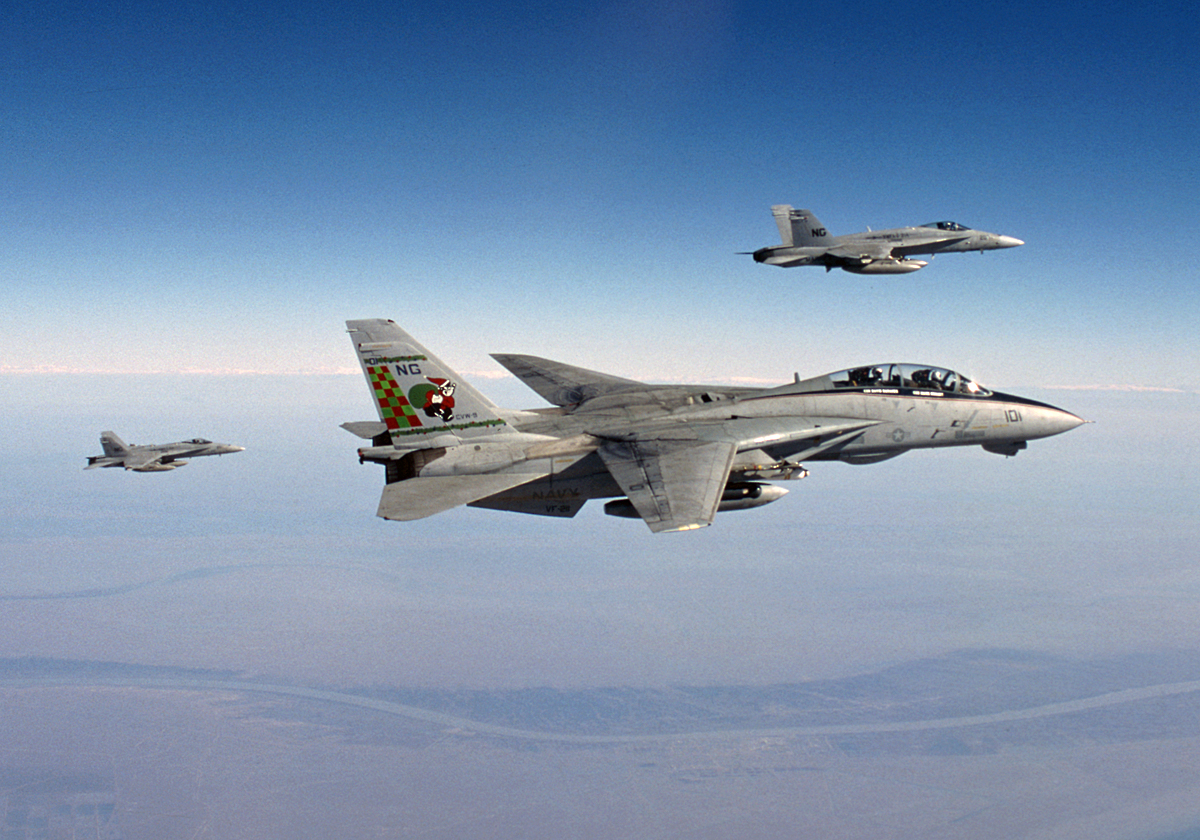For most people, the Christmas holidays bring happy celebrations with family and friends. For military personnel, however, separation from loved ones is more difficult over the holidays. In 1997 VF-211 did something to mark the situation.
The VF-211 Fighting Checkmates were part of Carrier Air Wing 9 and in September 1997 we deployed aboard the USS Nimitz (CVN-68) to support Operation Southern Watch in Iraq. The squadron consisted of 320 people operating fourteen F-14A Tomcats. We were a hard-working group with a lot of pride in our jets and our squadron. I was the commanding officer (CO).
By December we had made great improvements in the condition of our jets after months of hard work by our sailors. Several people mentioned that when the squadron was deployed during Christmas 1995, they had painted the Grinch on the tails of the CO’s jet, NG101. The Grinch is familiar to Americans from the popular book and TV show “How the Grinch Stole Christmas,” by children’s author Dr. Seuss.

I liked the idea of a special tail design but wanted something more positive than the Grinch, so I asked for suggestions from anyone in the squadron. I received about ten suggestions, all worth considering, and chose the design submitted by one of our pilots, LCDR “Mach” Singletary, who was also the squadron maintenance officer. Mach’s design showed the character from the squadron logo, who we called Brutus, dressed as Santa Claus, complete with the bag of goodies. Some of us called the design “Santa Brutus.”
Once the design was selected, I turned to the Corrosion Control workcenter to convert it into crisp and durable tail art. After all, it would have to survive operational flights for weeks. The project was handled by 24 year old Aviation Structural Mechanic Airman (AMSAN) Michael Kreisher, who had been with VF-211 a couple of years, because his supervisor had noticed his talent and figured he was the best for this job.

I contacted Kreisher recently and he recalls using an overhead projector (look that one up if you’re too young to know!) in the ready room to scale up the design to the correct size for a Tomcat tail. “It was challenging to say the least,” he said. Of course I had them paint it on NG101, the CO’s jet – “my” F-14. (Bureau Number was 161856.) To have some efficiency, it was applied during a cycle of touching up the paint, the regular corrosion effort that keeps Navy aircraft in good condition in the harsh environment of carrier operations.
It took Kreisher time to create the stencil for each color and carefully cut them out. Then more time to place them in the exact position, apply the paint, and wait for it to dry before doing the next color. But he knew it would be a morale booster and added, “I had a blast making the design and painting Santa Brutus.”

When starting the project I hadn’t really thought about the finished product, and when I saw it I was stunned by its quality and impact. I couldn’t wait to get the jet on the flight deck and in the air.
I took photos of Santa Brutus during an Operation Southern Watch mission over Iraq on Christmas Day, December 25, 1997. When we assigned jets for that mission people thought I would want to fly 101, but I put myself in a different jet so I could take these photos.

Santa Brutus lasted about a month, then NG101 was painted with the standard VF-211 tail design, but in color. At that time we were allowed to paint one aircraft in color. Once we returned from deployment and the workload became more manageable, I asked the Corrosion Control work center to apply normal Brutus to NG101. Once again, AMSAN Kreisher was assigned and did an outstanding job.
Brutus didn’t last too long on the tail of NG101: I completed my CO tour in August 1998 and the next CO went with one of the squadron’s historic tail designs. I retired from the Navy in 1999 after serving 20 years. Michael Kreisher continued, also serving 20 years and retiring as an E-6. The Fighting Checkmates converted to F/A-18F Super Hornets in 2004. Brutus lives on, prominent on the patch of VFA-211.

Santa Brutus also lives on — as a 1/72 scale kit from Hasegawa that was released in 2013 (which also includes regular Brutus) and a 1/200 scale diecast model by Herpa released in 2017.
Author Dave “Bio” Baranek was a RIO with 2,500 flight hours in the F-14 Tomcat. He was the commanding officer of VF-211 from August 1997 to August 1998. His third book, Tomcat RIO, was published in 2020 and tells this story and many others from his career, along with dozens of his photos.
Photo by Dave “Bio” Baranek; Top Image: US Navy photo by CDR David Baranek

